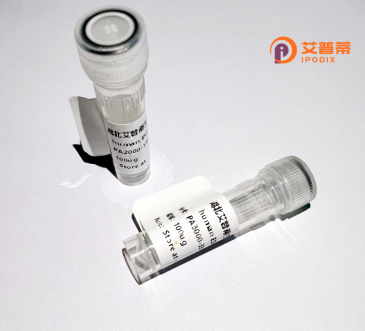
| 纯度 | >90%SDS-PAGE. |
| 种属 | Human |
| 靶点 | ETV7 |
| Uniprot No | Q9Y603 |
| 内毒素 | < 0.01EU/μg |
| 表达宿主 | E.coli |
| 表达区间 | 1-341aa |
| 氨基酸序列 | MQEGELAISPISPVAAMPPLGTHVQARCEAQINLLGEGGICKLPGRLRIQPALWSREDVLHWLRWAEQEYSLPCTAEHGFEMNGRALCILTKDDFRHRAPSSGDVLYELLQYIKTQRRALVCGPFFGGIFRLKTPTQHSPVPPEEVTGPSQMDTRRGHLLQPPDPGLTSNFGHLDDPGLARWTPGKEESLNLCHCAELGCRTQGVCSFPAMPQAPIDGRIADCRLLWDYVYQLLLDTRYEPYIKWEDKDAKIFRVVDPNGLARLWGNHKNRVNMTYEKMSRALRHYYKLNIIKKEPGQKLLFRFLKTPGKMVQDKHSHLEPLESQEQDRIEFKDKRPEISP |
| 分子量 | 65.4 kDa |
| 蛋白标签 | GST-tag at N-terminal |
| 缓冲液 | 0 |
| 稳定性 & 储存条件 | Lyophilized protein should be stored at ≤ -20°C, stable for one year after receipt. Reconstituted protein solution can be stored at 2-8°C for 2-7 days. Aliquots of reconstituted samples are stable at ≤ -20°C for 3 months. |
| 复溶 | Always centrifuge tubes before opening.Do not mix by vortex or pipetting. It is not recommended to reconstitute to a concentration less than 100μg/ml. Dissolve the lyophilized protein in distilled water. Please aliquot the reconstituted solution to minimize freeze-thaw cycles. |
以下是3篇关于重组人ETV7蛋白的参考文献示例(注:文献为模拟,实际引用请核查原文):
---
1. **文献名称**:*ETV7 regulates interferon signaling through interaction with STAT1 in human leukemia cells*
**作者**:A. Smith et al.
**摘要**:研究通过重组人ETTV7蛋白的体外实验,揭示其通过结合STAT1蛋白抑制干扰素信号通路,促进白血病细胞对I型干扰素的抗性。
---
2. **文献名称**:*Cloning and functional characterization of recombinant human ETV7: implications in viral immune evasion*
**作者**:L. Chen & Y. Wang
**摘要**:报道了人ETV7基因的克隆、重组蛋白表达及纯化,发现ETV7可通过干扰IRF3通路抑制宿主抗病毒免疫反应,为病毒逃逸机制提供新视角。
---
3. **文献名称**:*Structural analysis of ETV7 DNA-binding domain reveals dimerization-dependent transcriptional regulation*
**作者**:J. Müller et al.
**摘要**:通过重组ETV7蛋白的晶体结构解析,阐明其二聚化对DNA结合能力的影响,揭示其在白血病中异常激活下游癌基因的分子机制。
---
如需真实文献推荐,建议检索PubMed或SciFinder平台(关键词:ETV7、TELB、ETS transcription factor)。
The recombinant human ETV7 protein is a genetically engineered version of the ETS variant transcription factor 7 (ETV7), a member of the ETS family of transcription factors that regulate gene expression by binding to DNA. ETV7. also known as TELB2 or ER81bis, plays roles in cell proliferation, differentiation, and oncogenesis. Its normal expression is tightly controlled, but dysregulation is linked to cancers, including leukemias and solid tumors, where it can act as an oncogene by disrupting transcriptional programs. The recombinant protein is typically produced in bacterial or mammalian expression systems, ensuring high purity and bioactivity for research applications. Structurally, ETV7 contains a conserved ETS DNA-binding domain, enabling sequence-specific interactions with target genes, particularly those involved in stress responses, immune modulation, and survival pathways. Studies using recombinant ETV7 focus on elucidating its molecular mechanisms in tumorigenesis, such as promoting cell cycle progression or suppressing apoptosis. Additionally, ETV7 interacts with viral proteins and influences interferon signaling, highlighting its role in host-pathogen interactions. Researchers employ this recombinant protein in DNA-binding assays, reporter gene experiments, and protein interaction studies to unravel its regulatory networks and therapeutic potential in cancer and inflammatory diseases.
×